Dynamic Behaviors of a Single Species Stage Structure Model with Michaelis–Menten-TypeJuvenile Population Harvesting
Abstract
:1. Introduction
2. Existence and The Types of Equilibria
2.1. The Boundary Equilibrium
- (i)
- If m is odd and , is the unstable node.
- (ii)
- If m is odd and , is the saddle.
- (iii)
- If m is even, is the saddle node.
- (1)
- is a saddle if .
- (2)
- is a stable node if .
- (3)
- is a saddle node if and ; is a saddle if , , and ; is a stable node if , , and .
- and and are power series in with terms satisfying .
2.2. The Internal Equilibria
- (1)
- when , there are three distinct internal equilibria: is a saddle, and is a stable node, in which .
- (2)
- when :
- (i)
- when , there are two distinct internal equilibria: is the degenerate equilibrium, and (or ) is a stable node that is an elementary equilibrium, in which .
- (ii)
- when , there is only one internal equilibrium , and it is a degenerate equilibrium.
- (3)
- when , there is a unique internal equilibrium , and it is a stable node.
3. Global Stability of Equilibria
4. Numerical Simulations
- (1)
- Let ; we have and , i.e., , then is globally asymptotically stable (see Figure 3). More precisely, when the birth rate of the juvenile species is much less than the threshold , both species will be driven to extinction.
- (2)
- Let ; by simple computation, we have and , i.e., , then is globally asymptotically stable (see Figure 4). That is to say, when when the birth rate of the juvenile species is much less than the threshold and if b satisfies , both species will coexist.
- (3)
- Let , and take , respectively, and . We have and , then both species will be driven to extinction. The influence of Michaelis–Menten-type harvesting on the model is shown in Figure 5. It shows that with b increasing, species will become extinct in a much shorter time; in other words, increasing the harvest area will accelerate the extinction of species.
- (4)
- Let , and take , respectively, and . We have and , then the model has a global asymptotically stable positive equilibrium . The influence of Michaelis–Menten-type harvesting on the model is shown in Figure 6. It shows that with b increasing, the density of species decreases; in other words, increasing the harvest area will reduce the species density.
5. Conclusions
Author Contributions
Funding
Acknowledgments
Conflicts of Interest
References
- Li, Z.; Han, M.; Chen, F. Global stability of stage-structured predator-prey model with modified Leslie-Gower and Holling-type II schemes. Int. J. Biomath. 2012, 6, 1250057. [Google Scholar] [CrossRef]
- Li, Z.; Han, M.; Chen, F. Global stability of a predator-prey system with stage structure and mutual interference. Discret. Contin. Dyn. Syst. B 2014, 19, 173–187. [Google Scholar] [CrossRef]
- Xiao, Z.; Li, Z.; Zhu, Z.; Chen, F. Hopf bifurcation and stability in a Beddington-DeAngelis predator-prey model with stage structure for predator and time delay incorporating prey refuge. Open Math. 2019, 17, 141–159. [Google Scholar] [CrossRef]
- Ma, Z.H.; Li, Z.Z.; Wang, S.F.; Li, T.; Zhang, F.P. Permanence of a predator-prey system with stage structure and time delay. Appl. Math. Comput. 2008, 201, 65–71. [Google Scholar] [CrossRef]
- Lei, C.Q. Dynamic behaviors of a stage-structured commensalism system. Adv. Differ. Equ. 2018, 2018, 301. [Google Scholar] [CrossRef] [Green Version]
- Zhang, F.; Chen, Y.; Li, J. Dynamical analysis of a stage-structured predator prey model with cannibalism. Math. Biosci. 2019, 307, 33–41. [Google Scholar] [CrossRef]
- Chen, F.; Xie, X.; Li, Z. Partial survival and extinction of a delayed predator-prey model with stage structure. Appl. Math. Comput. 2012, 219, 4157–4162. [Google Scholar] [CrossRef]
- Chen, F.; Chen, W.; Wu, Y.; Ma, Z. Permanece of a stage-structured predator-prey system. Appl. Math. Comput. 2013, 219, 8856–8862. [Google Scholar]
- Chen, F.; Wang, H.; Lin, Y.; Chen, W. Global stability of a stage-structured predator-prey system. Appl. Math. Comput. 2013, 223, 45–53. [Google Scholar] [CrossRef]
- Yue, Q. Permanence of a delayed biological system with stage structure and density dependent juvenile birth rate. Eng. Lett. 2019, 27, 1–5. [Google Scholar]
- Pu, L.; Miao, Z.; Han, R. Global stability of a stage-structured predator-prey model. Commun. Math. Biol. Neurosci. 2015, 2015, 5. [Google Scholar]
- Lin, Y.; Xie, X.; Chen, F.; Li, T. Convergences of a stage-structured predator-prey model with modified Leslie-Gower and Holling-type II schemes. Adv. Differ. Equ. 2016, 2016, 181. [Google Scholar] [CrossRef] [Green Version]
- Xue, Y.L.; Pu, L.Q.; Yang, L.Y. Global stability of a predator-prey system with stage structure of distributed-delay type. Commun. Math. Biol. Neurosci. 2015, 2015, 12. [Google Scholar]
- Ji, L.L.; Wu, C.Q. Qualitative analysis of a predator-prey model with constant-rate prey harvesting incorporating a constant prey refuge. Nonlinear Anal. Real World Appl. 2010, 11, 2285–2295. [Google Scholar] [CrossRef]
- Xiao, A.; Lei, C.Q. Dynamic behaviors of a non-selective harvesting single species stage structure system incorporating partial closure for the populations. Adv. Differ. Equ. 2018, 2018, 245. [Google Scholar] [CrossRef]
- Chen, B.G. Dynamic behaviors of a nonselective harvesting Lotka-Volterra amensalism model incorporating partial closure for the populations. Adv. Differ. Equ. 2018, 2018, 111. [Google Scholar] [CrossRef] [Green Version]
- Lei, C.Q. Dynamic behaviors of a nonselective harvesting May cooperative system incorporating partial closure for the populations. Commun. Math. Biol. Neurosci. 2018, 2018, 12. [Google Scholar]
- Chen, F.D.; Wu, H.L.; Xie, X.D. Global attractivity of a discrete cooperative system incorporating harvesting. Adv. Differ. Equ. 2016, 2016, 268. [Google Scholar] [CrossRef] [Green Version]
- Zhang, N.; Chen, F.; Su, Q.; Wu, T. Dynamic behaviors of a harvesting Leslie-Gower predator-prey model. Discret. Dyn. Nat. Soc. 2011, 2011, 473949. [Google Scholar] [CrossRef] [Green Version]
- Lin, Q.F. Dynamic behaviors of a commensal symbiosis model with nonmonotonic functional response and nonselective harvesting in a partial closure. Commun. Math. Biol. Neurosci. 2018, 2018, 4. [Google Scholar]
- Su, Q.Q.; Chen, F.D. The influence of partial closure for the populations to a nonselective harvesting Lotka-Volterra discrete amensalism model. Adv. Differ. Equ. 2019, 2019, 281. [Google Scholar] [CrossRef]
- Xie, X.; Chen, F.; Xue, Y. Note on the stability property of a cooperative system incorporating harvesting. Discret. Dyn. Nat. Soc. 2014, 2014, 327823. [Google Scholar] [CrossRef]
- Huang, X.; Chen, F.; Xie, X.; Zhao, L. Extinction of a two species competitive stage-structured system with the effect of toxic substance and harvesting. Open Math. 2019, 17, 856–873. [Google Scholar] [CrossRef]
- Liu, Y.; Xie, X.D.; Lin, Q.F. Permanence, partial survival, extinction, and global attractivity of a nonautonomous harvesting Lotka-Volterra commensalism model incorporating partial closure for the populations. Adv. Differ. Equ. 2018, 2018, 211. [Google Scholar] [CrossRef] [Green Version]
- Chen, B.G. The influence of commensalism on a Lotka-Volterra commensal symbiosis model with Michaelis–Menten-type harvesting. Adv. Differ. Equ. 2019, 2019, 43. [Google Scholar] [CrossRef] [Green Version]
- Kong, L.; Zhu, C.R. Bogdanov-Takens bifurcations of codimensions 2 and 3 in a Leslie Gower predator-prey model with Michaelis–Menten-type prey harvesing. Math. Methods Appl. Sci. 2017, 40, 6715–6731. [Google Scholar] [CrossRef]
- Yu, X.Q.; Chen, F.D.; Lai, L.Y. Dynamic behaviors of May type cooperative system with Michaelis–Menten-type harvesting. Ann. Appl. Math. 2019, 4, 3. [Google Scholar]
- Yu, L.; Guan, X.; Xie, X.; Lin, Q. On the existence and stability of positive periodic solution of a nonautonomous commensal symbiosis model with Michaelis–Menten-type harvesting. Commun. Math. Biol. Neurosci. 2019, 2019, 2. [Google Scholar]
- Liu, Y.; Zhao, L.; Huang, X.Y.; Deng, H. Stability and bifurcation analysis of two species amensalism model with Michaelis–Menten-type harvesting and a cover for the first species. Adv. Differ. Equ. 2018, 2018, 295. [Google Scholar] [CrossRef]
- Hu, D.P.; Cao, H.J. Stability and bifurcation analysis in a predator-prey system with Michaelis–Menten-type predator harvesting. Nonlinear Anal. Real World Appl. 2017, 33, 58–82. [Google Scholar] [CrossRef]
- Lin, Q.; Xie, X.; Chen, F.; Lin, Q. Dynamical analysis of a logistic model with impulsive Holling type-II harvesting. Adv. Differ. Equ. 2018, 2018, 112. [Google Scholar] [CrossRef]
- Xue, Y.L.; Xie, X.D.; Lin, Q.F. Almost periodic solutions of a commensalism system with Michaelis–Menten-type harvesting on time scales. Open Math. 2019, 17, 1503–1514. [Google Scholar] [CrossRef]
- Yu, X.Q.; Zhu, Z.L.; Lai, L.Y.; Chen, F. Stability and bifurcation analysis in a single-species stage structure system with Michaelis–Menten-type harvesting. Adv. Differ. Equ. 2020, 2020, 238. [Google Scholar] [CrossRef]
- May, R.M.; Beddington, J.R.; Clark, C.W.; Holt, S.J.; Laws, R.M. Management of multispecies fisheries. Science 1979, 205, 267–277. [Google Scholar] [CrossRef]
- Clark, C.; Mangel, M. Of schooling and the purse seine tuna fisheries. Fish. Bull. 1979, 77, 317–337. [Google Scholar]
- Zhang, Z.F.; Ding, T.R.; Huang, W.Z.; Dong, Z.X. Qualitative Theory of Differential Equation; Science Press: Beijing, China, 1992. [Google Scholar]
- Xiang, C.; Huang, J.; Ruan, S.; Xiao, D. Bifurcation analysis in a host-generalist parasitoid model with Holling II functional response. J. Differ. Equ. 2020, 268, 4618–4662. [Google Scholar] [CrossRef]
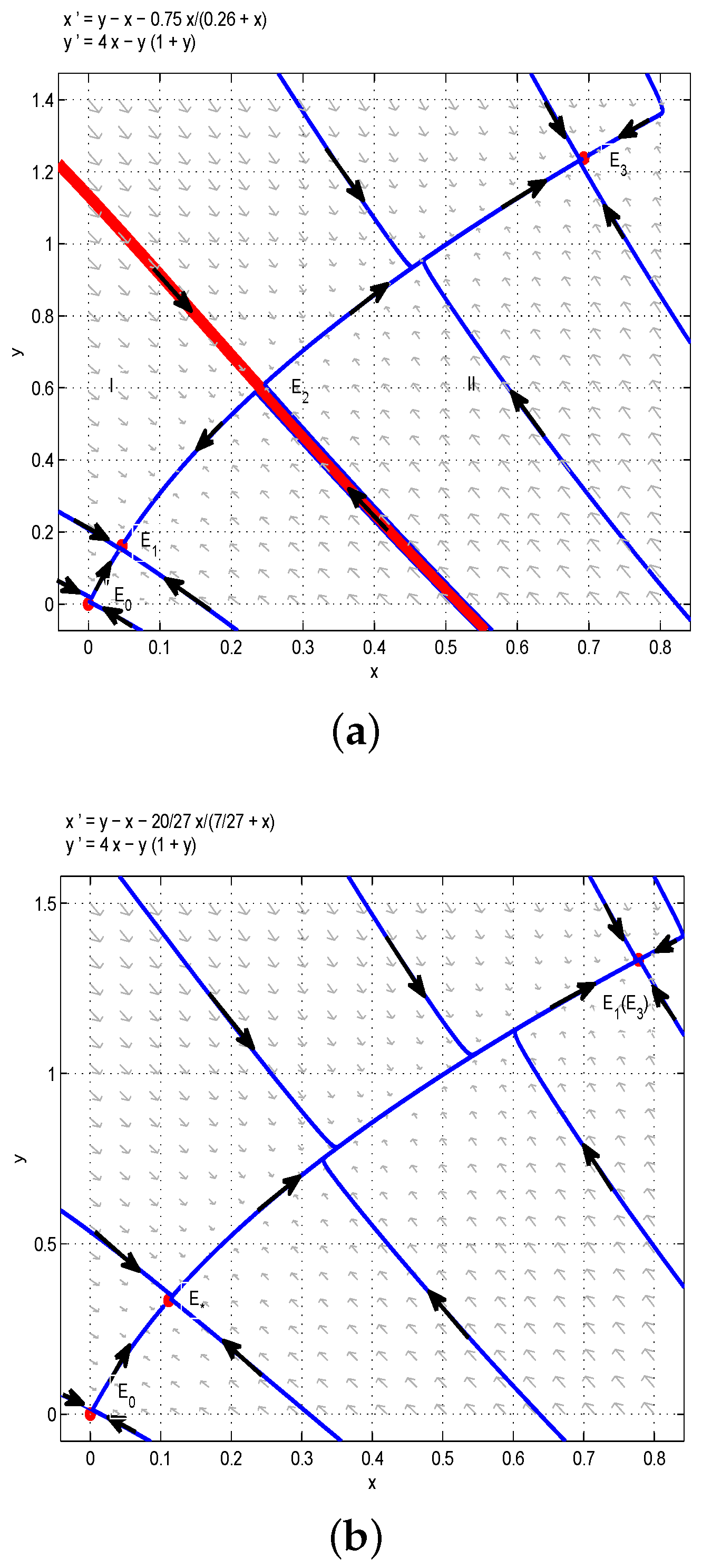
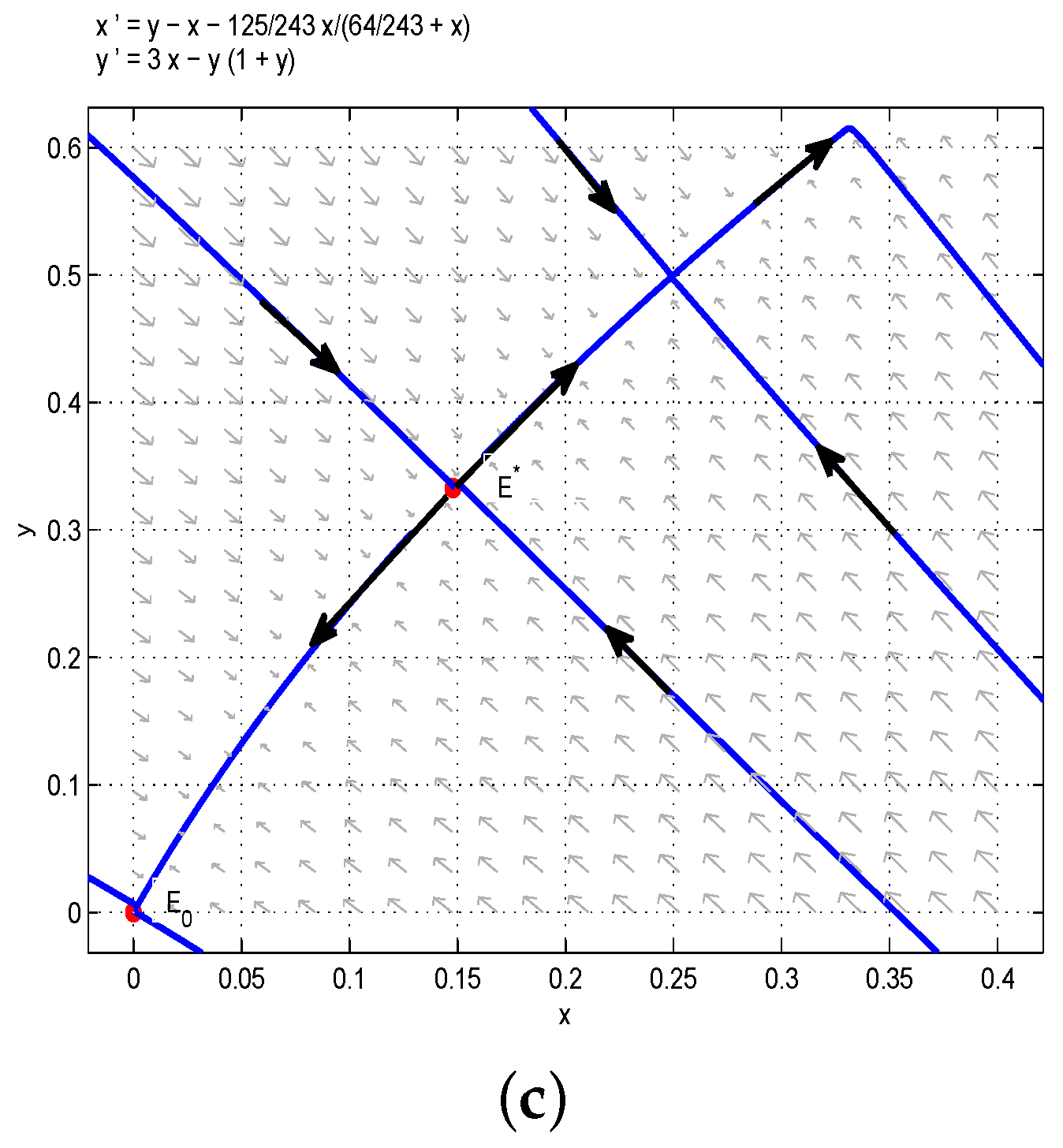
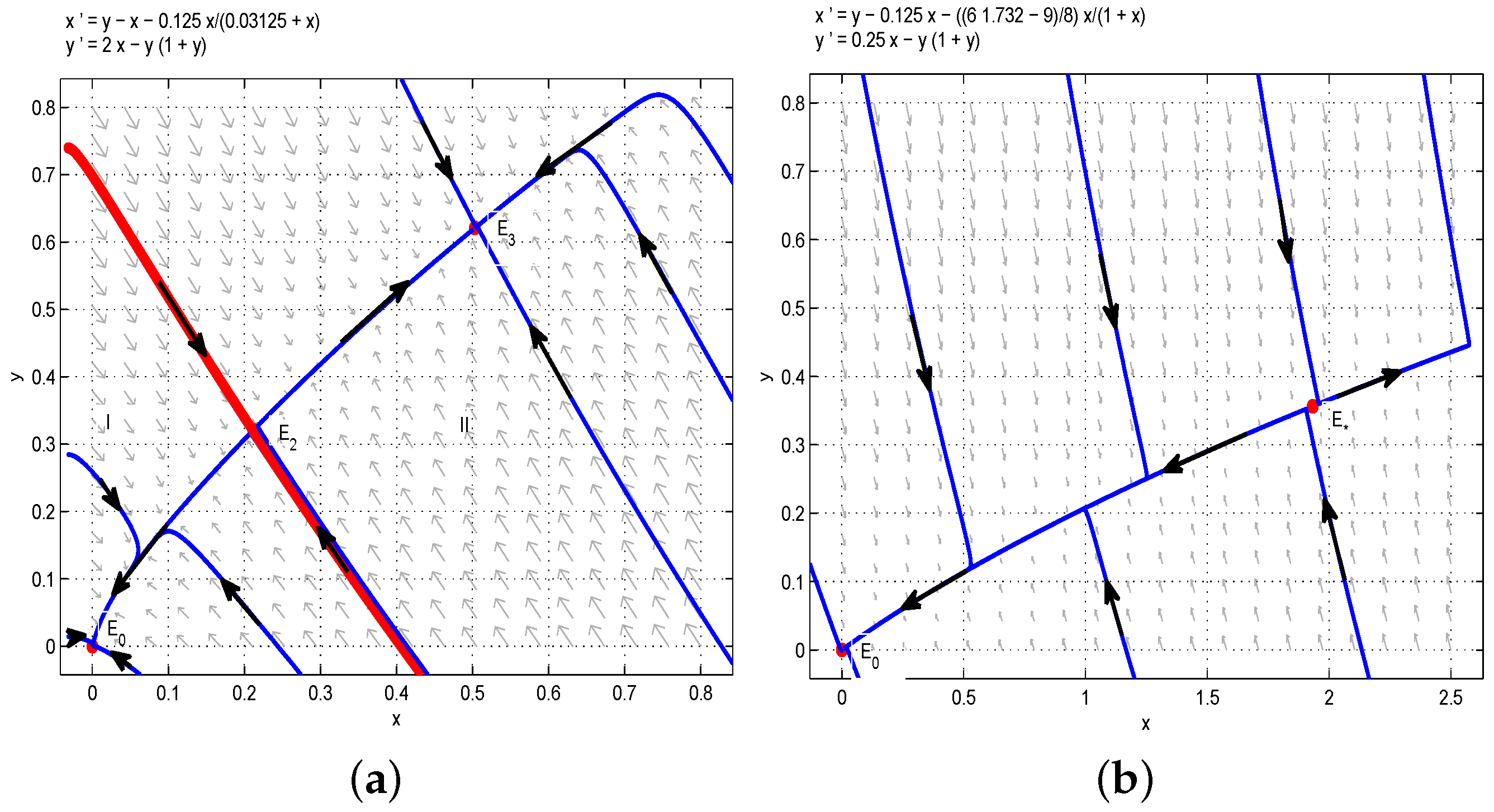
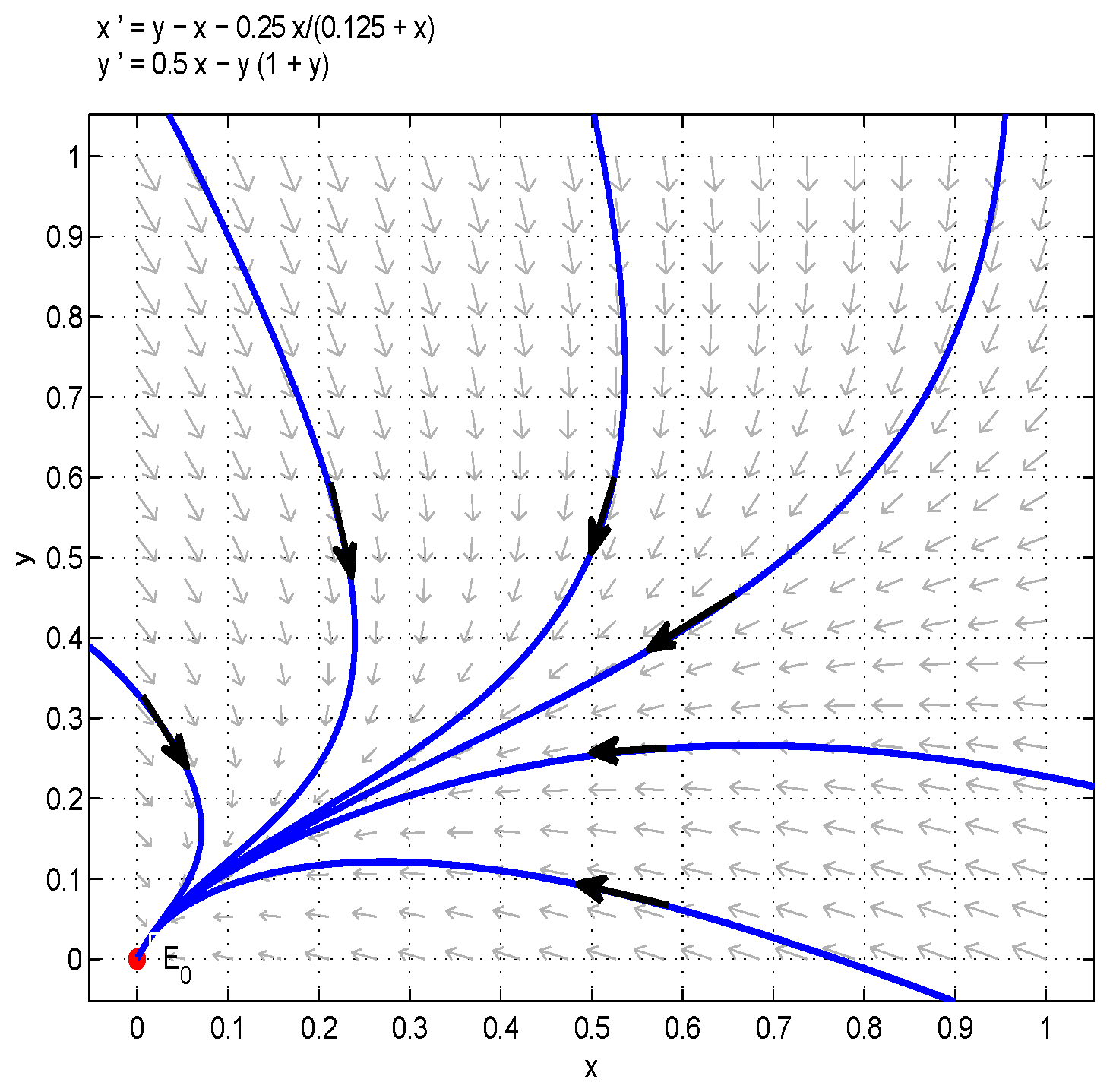

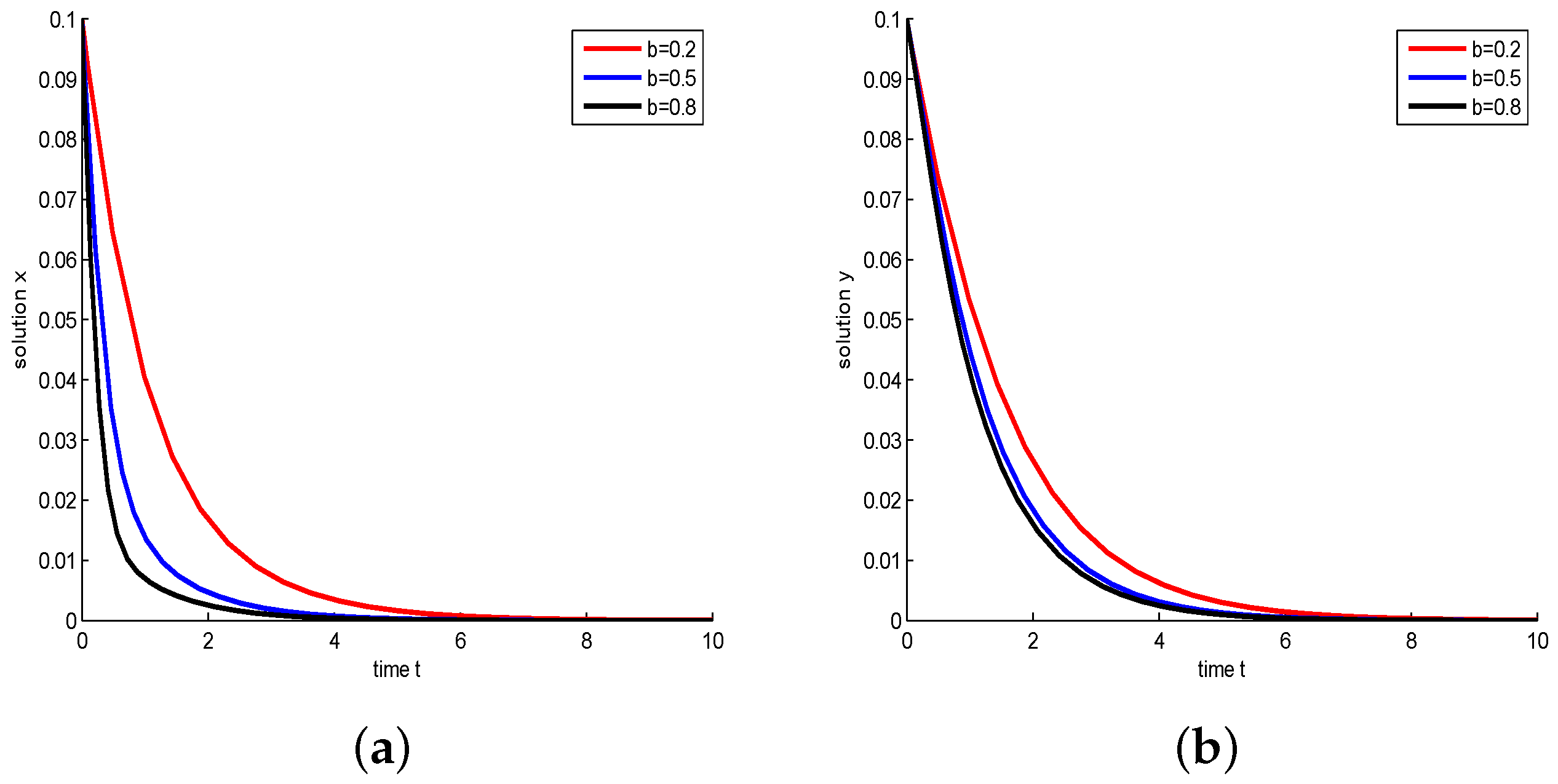

© 2020 by the authors. Licensee MDPI, Basel, Switzerland. This article is an open access article distributed under the terms and conditions of the Creative Commons Attribution (CC BY) license (http://creativecommons.org/licenses/by/4.0/).
Share and Cite
Yu, X.; Zhu, Z.; Chen, F. Dynamic Behaviors of a Single Species Stage Structure Model with Michaelis–Menten-TypeJuvenile Population Harvesting. Mathematics 2020, 8, 1281. https://doi.org/10.3390/math8081281
Yu X, Zhu Z, Chen F. Dynamic Behaviors of a Single Species Stage Structure Model with Michaelis–Menten-TypeJuvenile Population Harvesting. Mathematics. 2020; 8(8):1281. https://doi.org/10.3390/math8081281
Chicago/Turabian StyleYu, Xiangqin, Zhenliang Zhu, and Fengde Chen. 2020. "Dynamic Behaviors of a Single Species Stage Structure Model with Michaelis–Menten-TypeJuvenile Population Harvesting" Mathematics 8, no. 8: 1281. https://doi.org/10.3390/math8081281



